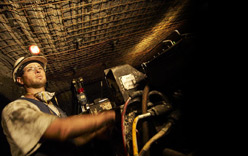SUBSIDENCE
Overview
Subsidence
occurs when large areas of coal are mined and the resulting settlement of roof
material into the void (the goaf) results in the surface subsiding over the affected
area. The degree of subsidence that may result from mining will be determined
by the thickness of coal extracted, the extent of the area mined, the nature of
overburden present above the coal seam, and other geological factors. With
shallow workings, subsidence at the surface may appear as sudden collapse of
areas of the surface with steep fractures apparent, but this is rare. More
commonly there is a gradual lowering of the surface strata which actually bends
rather than fractures at the limits of the subsiding area. This bending leads
to tensile strains in the surface strata (and possibly in structures on the
surface) which may result in the formation of cracks. It is around the edges of
the subsiding area where damage may occur. The central area of subsidence
usually is subjected to a gradual lowering, possibly suffering some tilt and
strain as the workings pass beneath. This may cause damage to such items as
roads and pipelines but this is easily repaired and there is little evidence of
it being a subsidence area after movement ceases. Structures, including houses,
built in mining areas should be designed to accept a small degree of tilt and
strain on a short term basis without suffering major damage.
In a mine where only first workings are used,
subsidence is unlikely to occur, however given that most mines undertake some
form of secondary extraction it will be an issue for the majority of mines. The
relative importance of subsidence at a given mine is largely dependent on the
nature of land use of the area above the workings.
Generally farming areas can accept considerable
subsidence with no ill effects, but the location of water bores, roads,
railways, any type of pipeline and possibly power lines must be considered.
There are also some types of farm buildings which may need protection (e.g. poultry
sheds, silos, etc).
It can be argued that the same can be said for
national parks, catchment areas (apart from dam walls) and similar areas, but
at present there is a prohibition on mining beneath national parks and much
discussion on subsidence effects on creek beds and cliff lines.
Subsidence effects on settled or industrial areas are
of major importance. In areas likely to be affected by mining, structures
should be designed to allow for subsidence where possible. In some cases mining
or at least secondary extraction may be prohibited due to the existence of
structures not designed to withstand such movement.
Mines in NSW contribute to a fund controlled by a
government authority (Mine Subsidence Board of NSW) to repair and/or compensate
building owners for subsidence damage that may occur as a result of mining in
Gazetted mining areas.
The amount of subsidence which occurs will depend on
the thickness of coal extracted, the depth of the seam below surface, the
strata types above the seam and the area of coal extracted (up to a certain
critical area). The effects on the surface will depend on the amount of
subsidence, the surface topography, the location of surface structures or items
relative to edges of extracted areas and the presence of any geological
structures. Note that "surface effects" may also have to be applied to
sub-surface items such as bores.
"Upsidence" is also a surface phenomenon associated with mining
and subsidence and occurs where workings pass beneath a gorge or similar
surface feature causing a concentration of horizontal stress in the strata
between the bottom of the feature and the top of any goaf cavity. This
increased stress may cause strata beds close to the surface to bend upwards and
possibly fracture.

